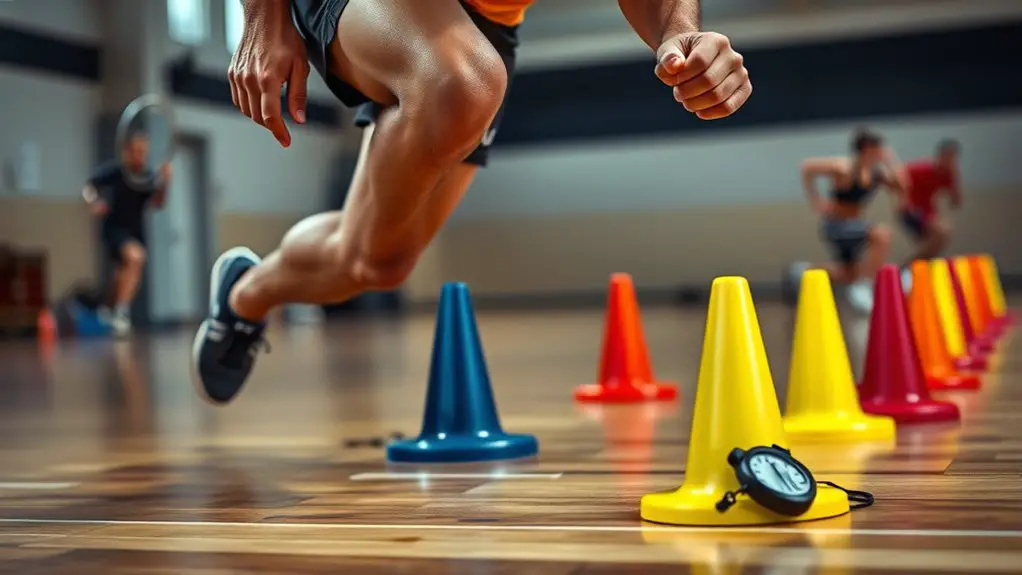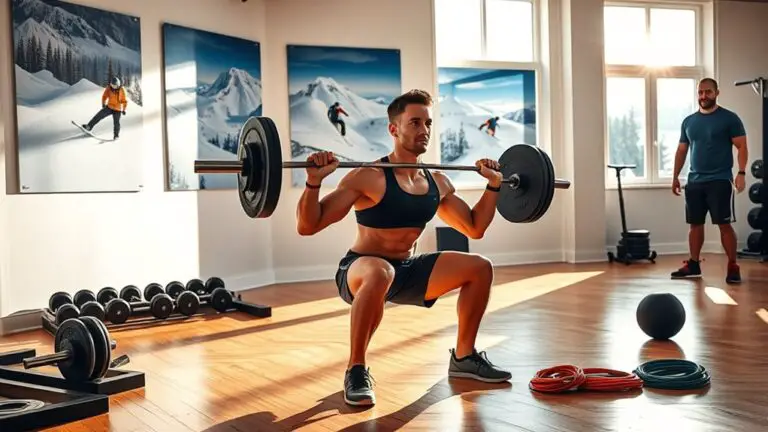How Gym Training Improves Agility and Speed for Athletes

Gym training boosts your agility and speed by focusing on strength development, explosive plyometrics, and targeted coordination exercises. As you build strength, you enhance muscle coordination and power output, essential for quick direction changes. Plyometric workouts elevate your force generation, while agility drills improve reaction times and overall performance. Combining these elements helps you optimize your movement patterns. Keep exploring the various strategies to elevate your athleticism and gain a competitive edge.
Understanding Agility and Speed in Athletics

When you think about athletic performance, agility and speed are often the essential factors that can set you apart from the competition. Agility, in simple terms, refers to your ability to change direction quickly while maintaining balance and control. It’s not just about moving fast; it’s about how efficiently you can adjust your position in response to dynamic situations. Speed mechanics, on the other hand, focus on the biomechanics of your running technique, including stride length, frequency, and overall efficiency. Understanding these concepts is vital for any athlete aiming to improve their performance. By honing your agility, you enhance your reaction time and coordination, key elements in competitive sports. Furthermore, mastering speed mechanics allows you to optimize your movement patterns, reducing energy wastage. Embrace training methods targeting both agility and speed, and you’ll elevate your athletic performance to new heights. Remember, every second counts in competition!
The Importance of Strength Training
While agility and speed are essential for athletic success, strength training serves as the foundation upon which these skills are built. You might not realize it, but developing your strength can greatly enhance your overall performance. Strength training benefits include improved muscle coordination, increased power output, and enhanced endurance—all vital for agile movement and rapid sprints. Additionally, incorporating skipping rope workouts can further boost your cardiovascular fitness and overall athleticism.
To maximize these advantages, focus on effective strength training techniques, such as compound lifts like squats, deadlifts, and bench presses. These exercises engage multiple muscle groups, promoting balanced strength development. Incorporating resistance bands and bodyweight exercises can also improve stability and functional strength, which directly translates to better agility and speed on the field or court.
Plyometrics: Building Explosive Power

Strength training lays the groundwork for athletic performance, but to truly excel, athletes need to incorporate plyometric exercises into their training regimen. Plyometric techniques focus on building explosive power through rapid stretching and contracting of muscles. These exercises, such as box jumps, squat jumps, and burpees, enhance your ability to generate force quickly, essential for sports requiring speed and agility.
By incorporating explosive movements into your routine, you’ll not only improve your vertical jump but also your overall athletic performance. Plyometrics develop fast-twitch muscle fibers, which are critical for sprinting and quick directional changes. Additionally, integrating exercises like pistol squats can further enhance your single-leg strength and stability, benefiting your overall agility.
Moreover, regular plyometric training can elevate your metabolism and improve cardiovascular endurance. Start with lower-intensity exercises and gradually increase complexity and height as your strength and technique improve. Embrace these dynamic workouts, and you’ll notice significant gains in speed and agility. Your athletic potential is waiting to be released!
The Role of Coordination Exercises
Although many athletes focus primarily on strength and explosive power, incorporating coordination exercises into your training is equally vital for optimizing performance. Coordination drills enhance your ability to control body movements, improving agility and reaction times. These exercises challenge your neuromuscular system, fostering better communication between your brain and muscles.
One effective way to incorporate coordination into your routine is through balance training. By practicing stability exercises on unstable surfaces, you’ll develop proprioception, which is important for maintaining control during high-intensity activities. This improved balance translates directly to better performance in your sport, allowing you to change directions quickly and efficiently.
Additionally, coordination drills can help prevent injuries by enhancing joint stability and muscle control. As you refine your coordination skills, you’ll find that they not only elevate your athletic performance but also boost your confidence on the field or court. Interestingly, exercises like jump rope can serve as both aerobic and anaerobic workouts, further enhancing your coordination and overall fitness. So, don’t overlook the power of coordination in your training regimen!
Incorporating Agility Drills Into Training

Incorporating agility drills into your training can greatly enhance your athletic performance by improving speed, coordination, and reaction time. You’ll find various types of agility exercises that can be tailored to fit your routine, whether you’re on the field or in the gym. Embracing these drills not only boosts your physical capabilities but also keeps your workouts engaging and effective.
Benefits of Agility Drills
Agility drills are essential for athletes looking to enhance their performance on the field or court, as they greatly improve coordination, speed, and reaction time. By incorporating dynamic movements into your training routine, you’ll develop the ability to change direction swiftly and maintain balance during high-intensity situations. This not only sharpens your physical capabilities but also boosts your mental agility, allowing you to make split-second decisions under pressure. Enhanced reaction time translates directly to improved performance, whether you’re dodging an opponent or sprinting to the finish line. Regularly practicing these drills will give you the competitive edge, fostering confidence and resilience as you push your limits. Prioritize agility training, and watch your athletic prowess soar.
Types of Agility Exercises
To maximize the benefits of agility drills, it’s important to understand the various types of exercises that can be integrated into your training regimen. Ladder drills are fantastic for improving foot speed and coordination, allowing you to navigate obstacles with precision. Cone sprints enhance your ability to change direction quickly, essential for game situations. Shuttle runs are excellent for building both speed and endurance, as they simulate the stop-and-go nature of most sports. Finally, agility hurdles challenge your explosiveness and overall body control, promoting better balance and strength. By incorporating these exercises into your routine, you’ll not only develop agility but also boost your overall athletic performance, helping you excel on the field or court.
Incorporating Agility Into Routine
When you make agility drills a regular part of your training routine, you can remarkably enhance your athletic performance. Incorporating agility ladders and cone drills into your workouts will develop your foot speed, coordination, and overall agility. Start by dedicating 10-15 minutes each session to these drills. For agility ladders, practice various foot patterns to improve quickness and precision. Cone drills, such as the T-drill or zig-zag sprint, challenge your change of direction and acceleration. Confirm you’re progressively increasing the complexity and intensity to keep your body adapting. Remember, consistency is key; the more you incorporate these exercises, the better you’ll become. By prioritizing agility training, you’ll gain a competitive edge in your sport. Stay focused and committed!
Enhancing Speed Through Resistance Training

Although many believe that speed is primarily a product of genetics and technique, incorporating resistance training into your regimen can greatly enhance your explosive power and overall speed. By focusing on strength circuits that incorporate resistance bands, you’ll develop the necessary muscle strength and endurance to improve your sprinting capabilities. Here are four effective strategies to enhance your speed through resistance training:
- Plyometric Drills: Incorporate jump squats or box jumps to build explosive power.
- Band Sprints: Use resistance bands while sprinting to develop acceleration and speed.
- Strength Circuits: Implement a circuit that includes squats, lunges, and deadlifts to strengthen your lower body.
- Speed Endurance: Perform speed endurance intervals with resistance to maintain high speeds over longer distances.
The Impact of Proper Nutrition on Performance
Proper nutrition is a game-changer for your athletic performance, and it starts with understanding nutrient timing and hydration. By strategically fueling your body before, during, and after workouts, you can maximize your energy levels and recovery. Staying hydrated isn’t just a side note; it’s essential for maintaining peak performance in every training session.
Nutrient Timing Strategies
Understanding nutrient timing strategies is essential for athletes aiming to optimize their performance. Implementing effective nutrient timing can enhance your agility and speed by ensuring your body has the right fuel when it needs it. Consider these key strategies:
- Pre-Workout Nutrition: Consume carbohydrates and protein 1-2 hours before training to boost energy levels.
- Post-Workout Recovery: Focus on protein and carbs within 30 minutes after your workout to replenish glycogen stores.
- Meal Frequency: Aim for 4-6 meals/snacks daily to maintain energy levels and support muscle recovery.
- Hydration Considerations: Maintain hydration throughout the day, as it directly impacts nutrient absorption and performance.
Hydration and Performance
When you consider the critical role hydration plays in athletic performance, it becomes clear that staying properly hydrated is just as important as your training and nutrition. Effective hydration strategies involve not just drinking water but also maintaining your electrolyte balance. Dehydration can lead to fatigue, decreased coordination, and impaired decision-making, all of which can hinder your agility and speed. To optimize your performance, incorporate electrolyte-rich fluids before, during, and after your workouts. Monitor your fluid intake and guarantee you’re replenishing lost electrolytes, especially during intense training sessions. Remember, proper hydration isn’t just a post-workout concern; it’s a continuous process that supports your overall athletic development. Stay hydrated, and you’ll enhance your training outcomes and athletic performance.
Real-World Success Stories: Athletes Who Benefit From Gym Training

While many athletes rely on their sport-specific skills to excel, incorporating gym training has proven to be a game-changer for countless competitors across various disciplines. Real-world examples highlight how structured gym workouts enhance agility and speed. Consider these athlete testimonials:
- Sprinter Success: A national-level sprinter improved his 100m time by 0.2 seconds through targeted strength training.
- Soccer Star: A professional midfielder reports enhanced sprinting capabilities, allowing for quicker shifts during matches.
- Basketball Player: A college player credits gym training for improved vertical leap, leading to more rebounds and blocks.
- Rugby Forward: A rugby athlete experienced better overall agility, enabling sharper cuts and improved tackling.
These real-world examples demonstrate that integrating gym training not only builds strength but also translates directly to performance improvements on the field. Moreover, it is important to recognize that proper technique can minimize the risk of injuries, allowing athletes to train effectively and safely. Embrace this approach, and you’ll likely see similar gains in your own athletic endeavors.
Frequently Asked Questions
How Often Should Athletes Train for Agility and Speed Improvements?
Think of your training like tuning a finely crafted instrument; too much practice without breaks can lead to a sour sound. For athletes, training frequency should ideally be three to four times a week, focusing on agility and speed. Incorporate recovery periods to allow your muscles to repair and grow stronger. This balance guarantees you’re not just pushing limits but also setting the stage for improved performance and reduced injury risk.
What Role Does Flexibility Play in Enhancing Agility and Speed?
Flexibility plays an essential role in enhancing your agility and speed. By incorporating flexibility training into your routine, you can improve your range of motion, allowing for quicker and more efficient movements. Dynamic stretching, in particular, prepares your muscles for high-intensity activities, reducing the risk of injury. When you focus on flexibility, you’ll notice greater control over your body, enabling faster reaction times and smoother changes during athletic performance. Keep pushing your limits!
Can Young Athletes Benefit From Gym Training for Agility and Speed?
Absolutely, young athletes can benefit immensely from gym training focused on agility and speed. Engaging in structured youth training programs enhances performance by developing strength, coordination, and flexibility. These elements are essential for improving quickness and responsiveness on the field or court. By incorporating specific exercises and drills, you’ll not only boost your athletic capabilities but also instill a strong foundation for future performance enhancement. Embrace the challenge—your potential is waiting to be released!
Are There Specific Warm-Up Routines for Agility and Speed Training?
Are you ready to elevate your performance? Specific warm-up routines are essential for boosting agility and speed. Start with dynamic stretches to activate your muscles, like leg swings and arm circles, which increase blood flow and flexibility. Then, incorporate plyometric exercises such as box jumps or lateral hops to enhance power and explosiveness. These routines prepare your body for intense training, keeping you sharp and ready to outpace your competition. Don’t overlook their importance!
How Do Mental Strategies Impact Agility and Speed Performance?
Mental strategies play an essential role in enhancing your agility and speed performance. By employing mental visualization, you can imagine yourself executing movements with precision, which can translate into improved physical execution. Additionally, focus techniques help eliminate distractions, allowing you to maintain peak concentration during training and competition. When you combine these strategies, you create a powerful mindset that enhances your physical capabilities and boosts your overall athletic performance.





